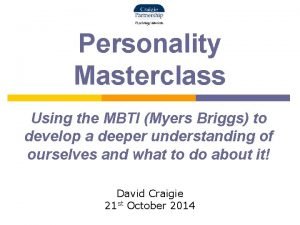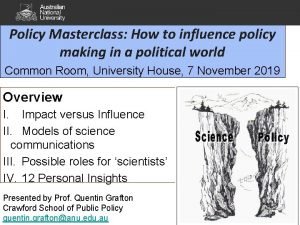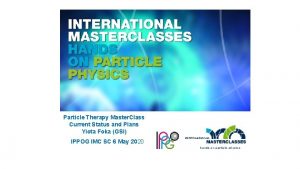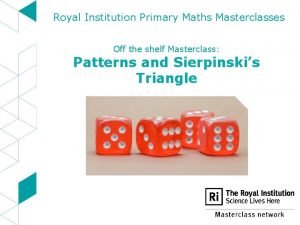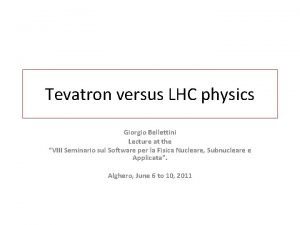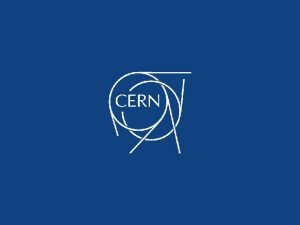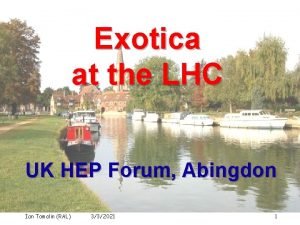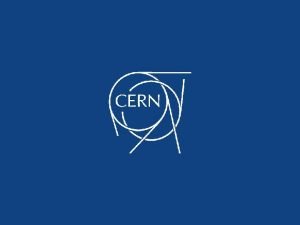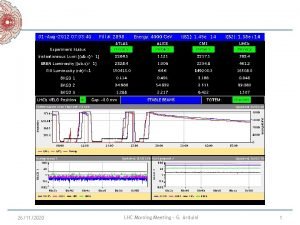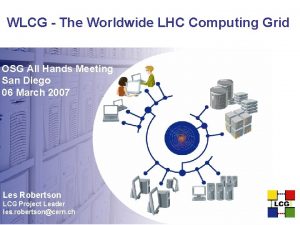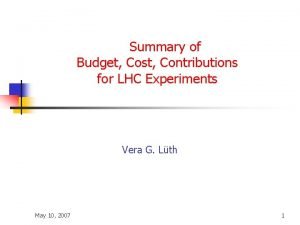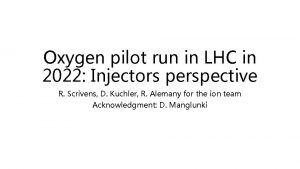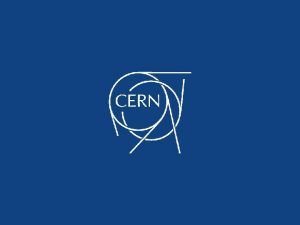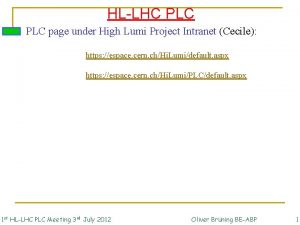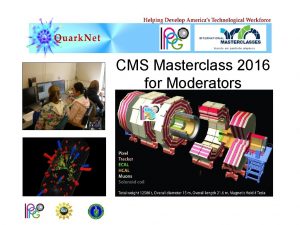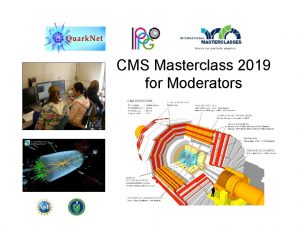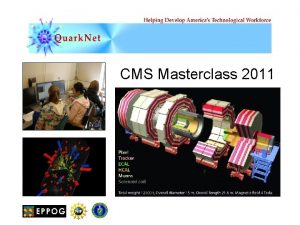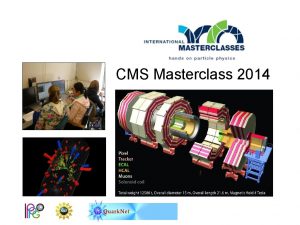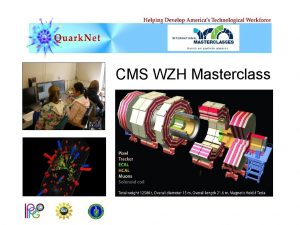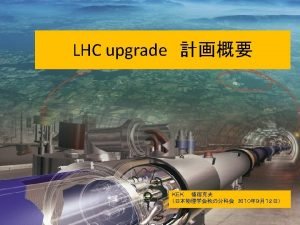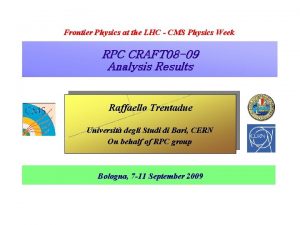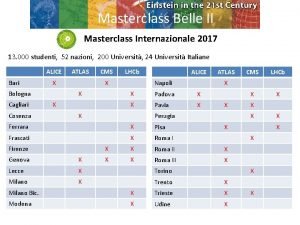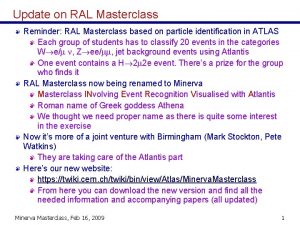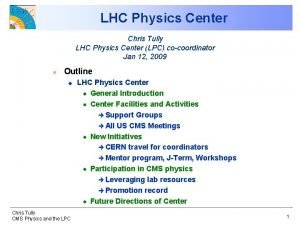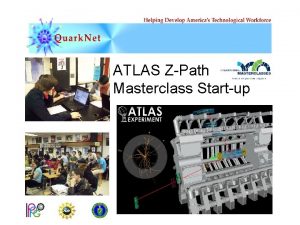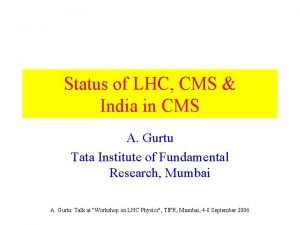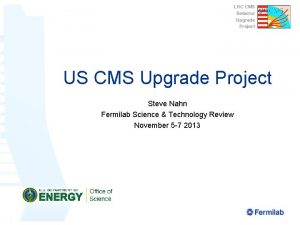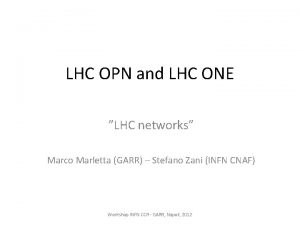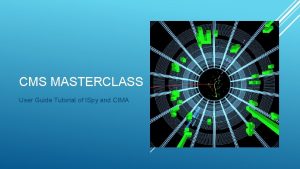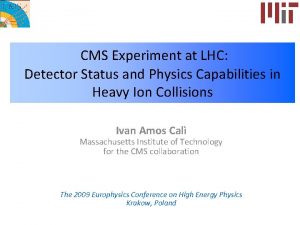CMS Masterclass 2016 The LHC and New Physics
























- Slides: 24

CMS Masterclass 2016

The LHC and New Physics It’s a time of exciting new discoveries in particle physics! At CERN, the LHC succesfully completed Run I at 8 Te. V of collision energy, confirming that the measurements correspond well to the Standard Model and then finding the Higgs boson. The LHC is now into Run II at an amazing 13 Te. V and the task is to look for new phenomena…and we are off to a great start.

The LHC and New Physics The LHC is buried ~100 m below the surface near the Swiss-French border. where beams cross and some particles collide

Detector Design Generic Design Cylinders wrapped around the beam pipe From inner to outer. . . Tracking Electromagnetic calorimeter Hadronic calorimeter Magnet* Muon chamber * location of magnet depends on specific detector design

Detector Tracks Web Version

Energy & Particle Mass We will look at Run I, in which proton energy is 4 Te. V*. • The total collision energy is 2 x 4 Te. V = 8 Te. V. • But each particle inside a proton shares only a portion. • So a newly created particle’s mass must be smaller than the total energy. *In Run II, this was increased to 6. 5 Ge. V!

Particle Decays The collisions create new particles that promptly decay. Decaying particles always produce lighter particles. Conservation laws allow us to see patterns in the decays. Try to name some of these conservation laws. film

Background Events Often, quarks are scattered by proton collisions. As they separate, the binding energy between them converts to sprays of new particles called jets. Electrons and muons may be included in jets. Software can filter out events with jets beyond our current interest.

W and Z Particles We are looking for the mediators of the weak interaction: + • electrically charged W boson, • the negative W boson, • the neutral Z boson. Unlike electromagnetic forces carried over long distances by massless photons, the weak force is carried by massive particles which restricts interactions to very tiny distances.

W and Z Particles The W bosons are responsible for radioactivity by transforming a proton into a neutron, or the reverse. Z bosons are similarly exchanged but do not change electric charge. Collisions of sufficient energy can create W and Z or other particles.

W and Z Particles The W bosons are responsible for radioactivity by transforming a proton into a neutron, or the reverse. Z bosons are similarly exchanged but do not change electric charge. Collisions of sufficient energy can create W and Z or other particles.

Higgs Particles The Higgs boson was discovered by CMS and ATLAS and announced on July 4, 2012. This long-sought particle is part of the “Higgs mechanism” that accounts for other particle having mass.

Higgs Particles The Higgs boson was discovered by CMS and ATLAS and announced on July 4, 2012. This long-sought particle is part of the “Higgs mechanism” that accounts for other particle having mass.

W and Z Decays Because bosons only travel a tiny distance before decaying, CMS does not “see” them directly. CMS can detect : • electrons • muons • photons CMS can infer: • neutrinos from “missing energy”

i. Spy-webgl

Today’s Task Use new data from the LHC in i. Spy to test performance of CMS: • Can we distinguish W from Z candidates?

Today’s Task • Can we calculate the e/m ratio?

Today’s Task • Can we calculate a W+/W- ratio for CMS?

Today’s Task • Can we make mass plot of Z candidates?

Today’s Task • Can we find rare H ZZ events? • Z e+e • Z m+m. Can we pick out electrons and/or muons? How should an event be filtered so we can recognize the correct tracks?

Today’s Task • Can we find some H gg events? How do we spot photons that leave no track? Where should we look? What should we see – and not see?

Recording event data Find your dataset. Record parent particles and decay modes.

Recording event data Mass Histogram and Results pages

Keep in Mind. . . “Science is nothing but developed perception, interpreted intent, common sense rounded out and minutely articulated. ” George Santayana • Indirect observations and imaginative, critical, logical thinking can lead to reliable and valid inferences. • Therefore: work together, think (sometimes outside the box), and be critical of each other’s results to figure out what is happening. Form teams of two. Each team analyzes 100 events. Talk with physicists about interpreting events. Pool results.
 Lhc tantalizing new physics
Lhc tantalizing new physics Masterclass of personality
Masterclass of personality Masterclass gastgerichtheid
Masterclass gastgerichtheid Masterclass.jsf?id=
Masterclass.jsf?id= Tom wang masterclass
Tom wang masterclass Particle therapy masterclass
Particle therapy masterclass Masterclass informatiebeveiliging
Masterclass informatiebeveiliging Technical analysis masterclass
Technical analysis masterclass Film directing masterclass
Film directing masterclass Royal institution masterclasses
Royal institution masterclasses Particle therapy masterclass
Particle therapy masterclass Branchekrachten
Branchekrachten Sleep masterclass
Sleep masterclass Tevatron vs lhc
Tevatron vs lhc Lhc louisiana
Lhc louisiana Hl-lhc schedule
Hl-lhc schedule Forum lhc
Forum lhc Lhc logbook
Lhc logbook Lhc morning meeting
Lhc morning meeting Worldwide lhc computing grid
Worldwide lhc computing grid Lhc budget
Lhc budget Lhc schedule 2022
Lhc schedule 2022 Lhc performance workshop
Lhc performance workshop Lhc performance workshop
Lhc performance workshop Hl intranet
Hl intranet

